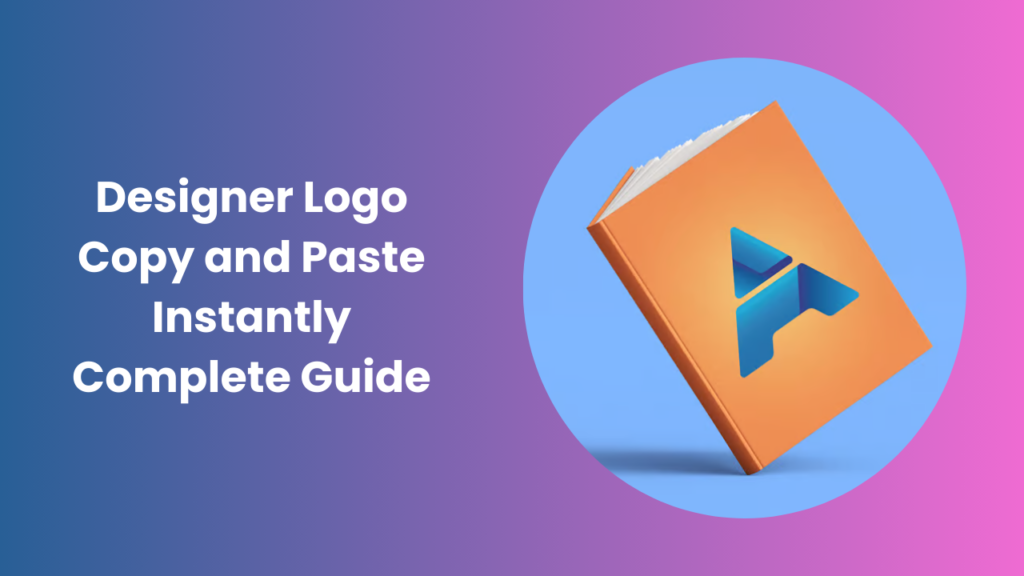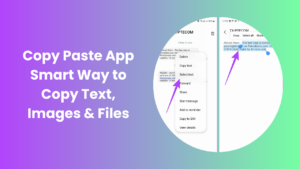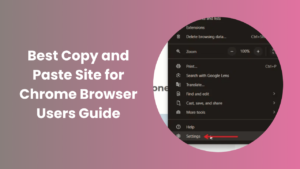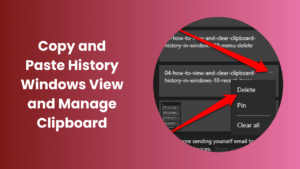In today’s fast-paced digital world, a logo is much more than just a visual element; it represents the core identity of a brand. Every business, content creator, and freelancer strives to create a professional image without spending endless hours designing from scratch. This is where designer logo copy and paste becomes a game-changer. These ready-made logos allow users to implement high-quality, professional designs instantly, saving both time and money.
Beyond speed and convenience, these logos also empower individuals and small businesses to maintain consistent branding across platforms without hiring a professional designer. They provide a starting point for creativity, allowing users to experiment with colors, fonts, and symbols before finalizing a design. In this guide, we’ll dive into the benefits, customization techniques, common mistakes to avoid, and practical tips for using ready-made logos to create a memorable and impactful brand identity that resonates with your audience. By understanding the principles of effective logo design, users can leverage these templates to establish a strong visual presence while saving resources and effort.
Understanding Designer Logos
A logo is the face of a brand, a visual symbol that communicates what a business stands for in just a glance. Designer logo copy and paste solutions are crafted with a combination of creativity, strategy, and technical skill. They take into account colors, shapes, typography, and visual hierarchy to convey a message effectively. Unlike basic clipart or generic images, these logos are intentionally created to reflect a brand’s personality, evoke emotions, and leave a lasting impression on the audience.
Creating a logo from scratch traditionally involves advanced software, design experience, and hours of trial and error. For small businesses, startups, or freelancers without professional design skills, this can be overwhelming. Ready-made designer logos bridge this gap by offering pre-designed templates that are easy to customize. Understanding the core design principles such as color psychology, balance, and readability—helps users choose a template that aligns perfectly with their brand’s identity. This ensures that even a pre-made logo communicates professionalism, creativity, and consistency.
How Ready-Made Logos Work
Ready-made logos work by offering pre-designed visuals that users can copy and paste directly into their projects. These platforms typically provide a wide variety of templates suitable for different industries, styles, and preferences. Once a design is chosen, it can be customized to suit the brand’s colors, fonts, and overall aesthetic.
The accessibility of ready-made logos is one of their greatest advantages. Even individuals with no design experience can implement them seamlessly across websites, social media profiles, marketing campaigns, or business stationery. Many platforms also provide high-resolution files and vector formats, ensuring that logos maintain clarity and professionalism across all media. Additionally, some platforms offer integration with branding kits, allowing users to apply consistent colors, typography, and visual elements across all digital and print assets. By understanding how these tools work, users can save significant time and effort while achieving results that rival professionally custom-designed logos.
Choosing the Right Logo
Selecting the right logo involves more than picking an attractive design. It requires thoughtful consideration of a brand’s identity, target audience, and long-term goals. A successful logo should be relevant, immediately communicating the brand’s message. It should also be memorable, helping the brand stand out in a crowded market, and versatile, ensuring it works across multiple platforms including websites, social media, printed materials, and merchandise.
Timelessness is another key factor. A logo that follows fleeting design trends may appear outdated within a few years, while a thoughtfully crafted logo can remain effective for decades. Platforms offering ready-made logos often categorize templates by industry or style, simplifying the selection process. By carefully evaluating options, visualizing the logo’s application, and considering customization possibilities, users can make a choice that not only looks great but supports long-term brand growth.
Customizing Your Logo
Many people assume that pre-designed logos are rigid, but most ready-made templates allow significant customization. Users can modify colors, fonts, layouts, and symbols to ensure the final result is unique and reflective of their brand.
Customization is essential for creating a logo that resonates with the target audience. For example, a technology startup may select sleek, modern fonts and subtle gradients to convey professionalism and innovation. Conversely, a lifestyle or entertainment brand may use playful icons and vibrant colors to communicate energy and creativity. The ability to personalize pre-made logos allows users to balance convenience with originality, ensuring that their branding remains distinctive in a competitive market.
Benefits of Using Ready-Made Logos
Using ready-made logos offers numerous benefits. First, they save time, eliminating the need to design a logo from scratch. Second, they are cost-effective, providing professional-quality designs without the expense of hiring a designer. Third, they inspire creativity by offering a wide range of styles, helping users refine their branding strategy.
Moreover, ready-made logos make professional design accessible to anyone, regardless of technical skill. Small businesses, bloggers, freelancers, and startups can all benefit from these convenient templates, gaining a polished visual identity without significant investment. By understanding the advantages, users can strategically use these logos to maintain consistency, enhance recognition, and build trust with their audience.
Popular Platforms
Several platforms provide high-quality ready-made logos. CoolText offers a vast collection of text-based logos, icons, and graphic designs that can be easily customized and implemented. Users can adjust fonts, colors, and symbols to create a logo that aligns perfectly with their brand identity.
EmojiCombos offers a playful alternative, allowing users to combine emojis and symbols to create unique, eye-catching logos. This is especially appealing for social media influencers, content creators, and small businesses looking for fun, modern branding visuals. Both platforms demonstrate the versatility of ready-made logos, catering to a wide range of industries, styles, and preferences.
Common Mistakes to Avoid
Even with ready-made logos, errors can affect branding effectiveness. Overusing default templates without customization can result in generic logos that fail to stand out. Neglecting scalability is another common mistake; logos must remain legible and visually appealing across all sizes, from social media icons to printed banners.
Consistency with the brand’s overall visual identity is crucial. Colors, fonts, and messaging should align with existing branding to reinforce recognition. Ignoring these factors can confuse audiences and weaken brand credibility. By understanding these pitfalls, users can maximize the effectiveness of ready-made logos while avoiding common mistakes.
Maintaining Your Logo
A logo should evolve alongside the brand. Periodic reviews and updates ensure it remains visually appealing, relevant, and consistent with current trends. Minor adjustments to colors, typography, or design elements can modernize a logo without altering its fundamental identity.
Monitoring logo usage across platforms is also critical. Ensuring consistency in digital and print formats strengthens recognition, builds trust, and reinforces the brand’s visual identity. Proactive logo maintenance enhances long-term brand value, ensuring that the brand remains memorable and professional.
FAQs
Can I use these logos for professional purposes?
Yes, most ready-made logos are suitable for business use. Minor adjustments to colors, fonts, or icons can ensure uniqueness while maintaining a professional look.
Are these logos free?
Some platforms provide free logos, often with limitations like watermarks or restricted resolution. Premium options typically offer full commercial rights and high-quality files.
How can I make my logo unique?
Even pre-made logos can be personalized by adjusting elements such as colors, typography, or symbols. Avoid using templates without customization to stand out from competitors.
Can I edit a logo after copying it?
Absolutely. Most platforms allow changes to fonts, colors, symbols, and layouts, ensuring the logo aligns perfectly with your brand identity.
Which platform is best for ready-made logos?
Platforms like CoolText and EmojiCombos are popular due to their wide variety of templates and customization options. Your choice depends on your industry and branding needs.
How often should I update my logo?
Minor updates every few years help keep a logo modern and relevant. Adjustments such as subtle changes to colors or fonts can maintain visual appeal without losing recognition.
Conclusion
Using designer logo copy and paste solutions allows businesses, freelancers, and content creators to establish a strong, professional brand identity quickly and affordably. These ready-made logos save time and effort, eliminating the need for advanced design skills or expensive software while still delivering a polished and visually appealing result. By carefully selecting templates that align with their industry and target audience, and customizing elements such as colors, fonts, and layouts, users can create a visual presence that is memorable, versatile, and consistent across all platforms.
Whether launching a new brand or refreshing an existing one, ready-made logos offer a practical and flexible approach. They allow users to maintain brand cohesion across websites, social media, marketing materials, and merchandise, ensuring that every touchpoint communicates professionalism. Additionally, these logos help small businesses and freelancers appear more established, enhancing audience perception and trust.





